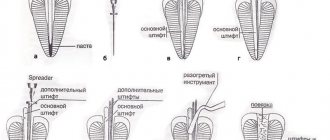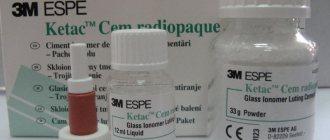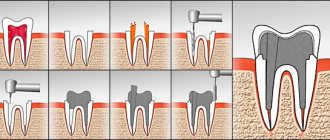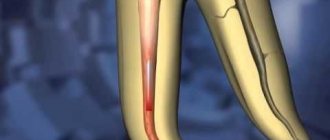Root canal filling is a therapeutic procedure in which the dentist disinfects and seals the root canals after removing the pulp tissue. The main goals of using this technique are:
- blocking access of pathogenic microorganisms to root canals;
- general strengthening of teeth.
In modern dentistry, several methods of filling root canals are used (depophoresis, obturation with hot and cold gutta-percha, and others). Let's look at each of them in more detail.
Depophoresis
Depophoresis is a therapeutic technique that allows you to completely disinfect the canal and make it sealed using a specialized device.
The procedure includes:
- anesthesia;
- exposure of the mouth of the root canal;
- introduction of an electrode with a negative charge into the root canal;
- applying a second electrode to the outer surface of the cheek, delivering a 2mA discharge and passing copper-calcium hydroxide through the root passage;
- treating the canal with a 10% suspension of calcium hydroxide or distilled water.
The average duration of the depophoresis procedure is 7-8 minutes. In this case, for a complete cure, the patient may need at least 3 sessions. In the pauses between these sessions, the root canal is filled with copper-calcium hydroxide paste. At the end of the procedure, the root passages are sealed with specialized dental cement.
Carrying out depophoresis can hardly be called affordable. However, the high cost of the procedure can be considered adequate if we take into account its high efficiency.
How to use hair filler
The product is packaged in small bottles of 13 ml each. This amount is enough for one-time use.
- Before using hair filler, wash your hair with a deep cleansing shampoo. This is necessary to remove all contaminants and achieve a “creaking” effect. There is no need to use masks or conditioners.
- Dry your hair until almost dry.
- Take one bottle and pour its contents into a mixing bowl (not metal). The number of ampoules depends on the length of the hair. Up to the shoulders - 1 piece, below the shoulder blades - 1.5-2, to the waist - 3. You should also focus on the thickness of your hair.
- Add the same volume of water and mix until you get a creamy texture.
- Apply the product to your hair, distributing it evenly along the entire length, paying special attention to the ends. Do not apply to roots or scalp.
- Leave the filler on for 20 minutes. You can put on a shower cap, a thermal hat, or warm your hair for 5-7 minutes.
- After this, rinse off the composition with warm water without using shampoo and conditioner. There is no need to rinse your hair thoroughly, even if a thin film of filler remains, that’s okay. Hair will not look greasy and dirty.
- Brush your hair as usual.
The method of using hair fillers is similar to using regular masks, only the effect is noticeable immediately.
Pros and cons of hair fillers
- Hair is regenerated from the inside, at the cellular level.
- The strands acquire a beautiful shine, become elastic, soft and manageable.
- The product has a pleasant subtle aroma that soaks the hair.
- The acid-base balance of the scalp is normalized.
- The filler protects curls from the negative effects of the environment.
The product has only one drawback - the procedure takes 30 minutes.
The effect of using hair fillers
You will notice the result immediately. It will last 2-3 washes. Experts recommend using the product in a course of 3-4 applications. Then you will completely get rid of split ends, prevent hair fragility and hair loss. It is best to use filler once a week, then your hair will delight you with beauty, thickness, and softness.
Give yourself luxurious hair without visiting a beauty salon. Choose hair fillers in our catalog and be charming!
Filling with chilled gutta-percha
Gutta-percha is a resinous compound obtained from the milky sap of a number of plants and is a high-molecular hydrocarbon similar in composition to natural rubber. There are several methods for sealing root passages using this material:
- single pin technique (the treated root course will have a shape identical to the shape of the pin, after which the gutta-percha pin is placed in the prepared hole);
- lateral condensation technique (initially the base pin is inserted into the center of the stroke, then the side ones);
- sealing using a rotating capacitor;
- filling with gutta-percha softened with chemicals.
Teeth filling process
- Initial consultation, taking x-rays.
- Coordination of treatment methods and selection of the type of fillings to be installed.
- Anesthesia before therapeutic intervention (local anesthesia, sedation, in rare cases - general anesthesia).
- Preparation of damaged or caries-affected tooth tissues.
- Grinding and processing the surface of the filling for proper closure.
Filling temporary teeth (baby teeth) follows the same plan, however, in pediatric dentistry, more compatible and safe materials are used.
Obturation using the Thermofil system
“Thermophile” is a titanium, plastic or steel cone-shaped rod coated with gutta-percha, which is in the alpha phase state. This coating is characterized by a lower melting point, increased fluidity and the ability to penetrate into the microtubules of the root passage. When introducing thermophile into the root canal, the base rod fills the main space, and gutta-percha fills only a small part of it. This is what makes it possible to solve the problem of significant shrinkage of the thermoplastic gutta-percha filler after cooling and to prevent the formation of microspaces between the walls of the root passage and the filler.
The procedure for sealing root passages, which involves the use of the Thermofil system, consists of the following stages:
- selection of suitable thermophile diameter;
- antiseptic treatment of the rod and its heating;
- introduction of sealant into the root canal;
- inserting the rod into the root canal until it stops;
- removal of excess gutta-percha from the dental cavity;
- restoration of a damaged tooth crown.
The use of the described technique allows for effective obturation of the main canal and its branches.
Injection (liquid) gutta-percha technique
In this technique, gutta-percha is used in the form of blocks, which are placed in a heating device, in which gutta-percha is heated to a temperature of 185-200°C and fed into the canal in liquid form. alloescort
The liquid gutta-percha technique, when performing the protocol, ensures the penetration of gutta-percha and sealer into both the main root canal and the dentinal tubules . The increase in temperature on the outer surface of the root is insignificant and has minimal damaging effects on the tissue.
The effective use of this technique, however, is determined by the doctor's skills, developed and honed on extracted teeth.
Filling with hot gutta-percha
Sealing the root passages with heated gutta-percha can be done in several ways. The most common of them are:
- injection method (filling the channel with material heated to 200 degrees);
- method of vertical condensation (laying filling material into the canal, distributing it with instruments along the side canals, installing a softened pin on top of it);
- continuous wave method (introducing a basic central pin into the tooth using a heated instrument, placing side pins around it, completely sealing the canal).
Filling of anterior teeth
In the case of front teeth, the aesthetic aspect comes to the fore, so the filling material must have the appropriate properties. Although the front teeth receive better hygiene due to their accessibility, they are also susceptible to caries. Installing a filling on the front teeth is considered a more complex procedure: it is necessary not only to give the filling the desired shape, but also to choose the right color. In most cases, filling of anterior teeth is carried out using compomers, as well as light composite fillings, which harden under the influence of ultraviolet radiation. Be that as it may, in case of serious damage, it is impossible to achieve good aesthetics with the help of filling, so you often have to turn to orthopedic solutions.
Canal filling using E&Q Plus
This is a sealing of the dental canal with hot gutta-percha, which includes an injection gun with a special heating tip and a control unit. The equipment included in the system allows you to use three filling techniques at once:
- vertical compaction of preheated material;
- gutta-percha injection;
- a combination of the above techniques.
The standard procedure for filling root passages using this system includes the following steps:
- introduction of a sealer into the canal and application of a gutta-percha pin;
- condensation of the pin in the apical direction using a hot electric plugger;
- cutting off the coronal part of the gutta-percha pin;
- filling the root canal with heated gutta-percha using a special obturator-gun;
- Compacting gutta-percha using a cold plugger system.
There are other methods of sealing root canals, but they are used much less frequently than those described above. One way or another, a competent approach to this procedure allows you to quickly and painlessly fill the root canals, returning the teeth not only to their original functionality, but also to their aesthetic properties.
Materials for creating a filling
Various substances are used as filling materials. The choice is made depending on the wishes of the client and the doctor’s testimony. All modern preparations are of high quality and aesthetic appearance, allowing you to select color and transparency in exact accordance with the tooth.
Light-curing cements, composites and polymers have their own adhesive system that ensures reliable adhesion of the filling and tooth. The polymer hardens only under the influence of a special lamp, which gives the dentist as much time as he needs to form the filling.
Glass ionomer cements have high strength and a high cosmetic effect.
Depending on the filler particles, fillings are divided into macro, micro and hybrid composites. Most newer materials add fluorescent particles that match the natural glow of enamel in neon light.
To create strong fillings on lateral teeth with a large chewing surface, ceramic elements are added to the filling material, which makes the fillings resistant to heavy loads.
When restoring the front part of teeth and restoring chips, a group of aesthetic materials is used.
Flowable polymer matrix composites are used to penetrate hard-to-reach areas and achieve complete sealing.
The variety of materials available allows the dentist to choose the appropriate one for each specific case and each patient.
Biodegradable fillers
These include products consisting of synthetic components, such as silicone. They provide the longest lasting effect, but are not eliminated from the body on their own, unlike biosynthetic and biodegradable fillers. They can only be removed surgically. The disadvantages of drugs in this group also include allergenicity, the formation of compactions or depressions under the skin, and migration of the filler. It must be said that due to the large number of side effects, bionon-degradable fillers are now rarely used in cosmetology, giving way to safer drugs for correcting aesthetic imperfections and rejuvenating the face.
Also learn how to choose and apply hair fillers.
Gutta-percha in dentistry
Gutta-percha is used as a natural material in many fields. The product has also found its application in dentistry.
Gutta-percha is a material obtained by processing the well-known latex, which is produced from the juice of the Gutta-percha plant. This product has high plastic properties, but at the same time is able to maintain a solid shape. The material acquires softness and pliability only under the influence of high temperatures, so canals are often filled with hot gutta-percha.
In dentistry, special gutta-percha is used to make pins, which, after treating the canals during endodontic treatment, are installed directly into the tooth canal. However, such a pin consists of only 20% gutta-percha (the upper part of the product), while the base is made of zinc oxide. In order for the treatment to be of high quality and, as a result of filling, each canal cavity is filled, gutta-percha pins of different sizes in length and width are produced.
How much does the procedure cost?
The exact cost of dental filling is usually announced by the doctor at the initial consultation. The price will depend on the filling material used and the amount of work. Filling canals will cost more than simply installing a filling.
| Type of filling | Price |
| Cement filling | From 900 rubles |
| Glass ionomer filling | From 1,500 rubles |
| Filling made from a light-curing composite of the latest generation | From 3,500 rubles |
| Filling made from a chemocurable composite of the latest generation | From 2,500 rubles |










